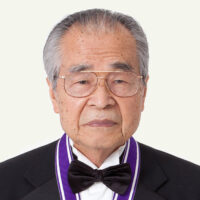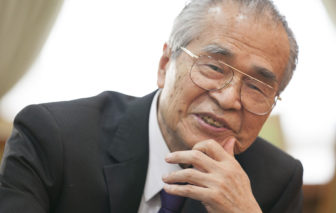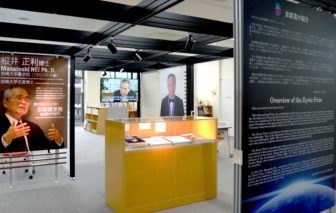
2013 Kyoto Prize Laureates
Biological Sciences(Evolution, Behavior, Ecology, Environment)
/ Evolutionary Biologist
1931 - 2023
Professor, Pennsylvania State University
Theory and Reality of Evolutionary Biology
2013
11 /11 Mon
Place:Kyoto International Conference Center
From Molecular Population Genetics to Comparative Genomics
2013
11 /12 Tue
13:00 - 16:50
Place:Kyoto International Conference Center
Dr. Masatoshi Nei made it possible to discuss evolutionary divergence, genetic diversity, and the mode of selection on genes in a quantitative manner by devising diverse statistical methods such as Nei’s genetic distance, and applying them to molecular data. Using these methods, Dr. Nei’s research has yielded important contributions to molecular evolutionary biology, as well as many other academic disciplines including ecology and conservation biology.
Dr. Masatoshi Nei contributed greatly to the transformation of evolutionary biology into an exact science by developing diverse statistical methods to analyze variations in proteins and DNA nucleotide sequences. Evolution occurs through the repeated appearance of novel mutations that propagate within a population and ultimately replace earlier genes. Dr. Nei’s methods of analysis facilitated a quantitative study of genetic variation and evolutionary time—yielding an understanding of evolutionary phenomena based on molecular data for a wide range of species, from unicellular organisms to human beings, in three major ways.
First, Dr. Nei developed “Nei’s genetic distance,” which quantifies differences between populations in terms of allele and allozyme frequencies. Genetic distance has made it possible to estimate migration rates between populations, and to know the time of splitting of populations or species. Using this principle, Dr. Nei solved a major evolutionary question by estimating the divergence time of three major genetically differentiated human groups—Caucasoid, Negroid and Mongoloid—using genetic distance based on protein polymorphism. He also developed a series of new methods, including GST (the coefficient of gene differentiation) and nucleotide diversity. With these techniques, Dr. Nei’s work became instrumental for refining the measurement of evolutionary differentiation and genetic diversity within and between populations.
Second, Dr. Nei and his collaborators developed tools to establish phylogenetic relationships between genes. Especially notable is the “neighbor-joining method” for a molecular phylogenetic tree. This very efficient algorithm has been adopted extensively to produce phylogenetic trees that include many species. In a related major achievement, Dr. Nei clarified the relationship between species phylogeny and gene phylogeny. Today, his methods remain standard tools for deducing phylogenetic relationships of closely related species, such as humans, chimpanzees and gorillas.
Third, Dr. Nei improved a method of estimating the rates of nucleotide substitution, for substitutions that change an amino acid and for those that do not, separately. Thus, the method became easier to use and gained widespread popularity. Dr. Nei showed that comparisons between two substitution rates could reveal the evolutionary mechanism of genes. One notable application of this technique was his demonstration of “positive selection” in the MHC gene cluster, which serves to maintain high genetic diversity.
Many analytical methods developed by Dr. Nei have contributed not only to evolutionary biology but also to a broad range of other academic disciplines, including ecology and conservation biology.
Dr. Nei has also written influential textbooks, helped establish an international society of molecular evolution, and founded its highly-cited scientific journal, thus making major contributions to the education of students and the general public.
For these reasons, the Inamori Foundation is pleased to present the 2013 Kyoto Prize in Basic Sciences to Dr. Masatoshi Nei.
Profile is at the time of the award.

In Memory of Dr. Masatoshi Nei, who Has Contributed Extensively to the Development of Molecular Evolutionary Biology
The 2013 Kyoto Prize Laureate in Basic Sciences, Dr. Masatoshi Nei, passed away at the age of 92. He has devised statistical methods for handling genetic information such as the “neighbor-joining method” and “Nei’s genetic distance,” which have contributed significantly to the quantitative analysis in evolutionary biology. He received the Kyoto Prize for his “Research...

New Exhibition Featuring Dr. Masatoshi Nei Opens at the University of Miyazaki
New exhibition featuring Dr. Masatoshi Nei, the 2013 Kyoto Prize laureate in Basic Sciences opened at the University of Miyazaki. Dr. Nei, an evolutionary biologist, proposed what is now called “Nei’s Genetic Distance,” which quantifies differences in the vestiges of evolution that remain within proteins and DNA in his 1972 paper. This innovative idea has...

Dr. Nei won the prestigious John Scott Award!
Approx. half century has passed since “Nei’s Genetic Distance” was announced in 1972. The method that Dr. Masatoshi Nei developed facilitated a quantitative and statistical analysis based on molecular data for the evolutional phenomena (how long ago the populations diverged on the evolutionary tree of life) which had been nothing but estimation or hypothesis. His...